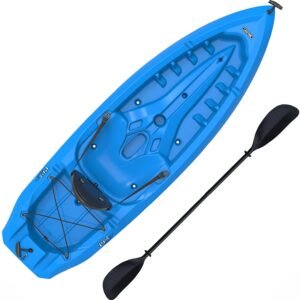No activity is risk-free. Sure, running is safer than rock climbing, but there’s always the risk of falling or spraining your ankle.
Kayaking is no exception.
What are the risks and dangers of kayaking though? And is kayaking safe? Let’s find out below.
Is kayaking safe?
Kayaks indeed are rugged and safe pieces of boating equipment. No wonder that people of various ages are engaged in the activity of kayaking. With that being said, kayaking is only safe when you are doing it properly.
Your kayak won’t be able to keep you warm in cold weather and cool in hot weather. It will not be able to protect you from a heatstroke. And no matter how sophisticatedly it is built, it is not going to withstand an impact with another vessel or river rocks.
So is kayaking safe? Yes, but kayaking is safe only if you are putting in the effort for it.
Now, let’s overview the major risks that could be lingering around during your kayaking trip.
The risks of kayaking
Weather conditions
Ah, weather, probably the first risk to come to mind when it comes to boating. Weather is the friend and enemy of any boat, be it big or small, and kayaks are no exception.
It’s obvious that you should not paddle in bad weather no matter how fun you think it will be or how confident you are in yourself. Weather is unpredictable, and so are changes in the water flow caused by wind or other elements.
Thus, only paddle in calm weather.
Be mindful of tidal rivers as well. As the name suggests, tidal rivers’ level is influenced by tides. The bottom of the river may get closer than what you’re used to, and vice versa.
Ignoring safety precautions
This is perhaps the biggest and most important risk that you should be aware of. No matter how great your kayak is or how excellent the kayaking spot is, if you ignore safety precautions, you can get in trouble.
Of utmost importance is to wear a lifejacket at all times while paddling, as we described in our post on kayaking safety tips. Not only that, but you need to make sure that you are wearing your PFD correctly.
A PFD needs to be snug on you but not too tight. It also needs to be of the right size. If you are struggling to pick a PFD size, our lifejacket buying guide may be able to help you.
Another mandatory thing to do is to dress properly for your trip. Cold weather puts forward its own requirements, and even warm weather needs the right approach. Check out our post on proper dressing for kayaking for specific dressing tips for different weather conditions.
Other boaters
Other boaters are also a risk, but not in the sense that they will try to bump into you. No – rather, you can’t really trust others’ experience and attention while on the water.
Trust no one more than yourself. Keep your eyes wide open and pay attention to what others are doing. If you are a driver, then it will be just like on the road, though there will be fewer boaters to look out for.
Sun exposure
Sun exposure is a big risk in sunny weather. It can lead to a variety of complications like dehydration, heatstroke, or even cancer if you are unlucky enough to be exposed to a sufficient amount of UV.
To prevent the damaging effects of sun exposure, you need to protect your skin and eyes – e.g. wear long-sleeved shirts & pants when possible, sunglasses, and a hat. For skin areas exposed to the sun – like your hands (if you aren’t wearing gloves) – use sunscreen for protection.
We have more details on proper dressing in hot weather in our dressing guide for kayaking.
Hypothermia
Hypothermia is the rapid loss of heat by the body. If you are warmly dressed, it’s unlikely for hypothermia to occur while you are inside your kayak in cold weather. Capsizing is a whole another story though – in cold water, the body loses heat several times faster than in cold air.
Cold shock is another complication that could arise from the sudden temperature change when your body gets submerged in the cold water. This change can cause breathing problems, confusion, blood pressure changes, and other issues that will disorient you.
Unlike hypothermia, cold shock is caused by short-term exposure to cold water. Hypothermia results from exposure to cold temperatures for a long time and could be caused by either cold water or air (though more likely water).
A proper approach to protecting yourself from the cold of the water is to dress for submersion. There are a few techniques you could use, with a couple of them described in our kayaking dressing guide.
Aside from that, you may want to paddle with someone else in cold weather since when disoriented from the exposure to cold, you might struggle to get back to the shore.
Dehydration
As mentioned above, dehydration can be caused by sun exposure, but it may also be caused by the mere lack of water intake. Kayaking is quite a resource-intensive activity, and water is crucial to ensuring that you are full of energy.
Among the signs of dehydration are fatigue, dizziness, extreme thirst, confusion, all of which can negatively impact your paddling ability.
Always carry water with you during the journey. The longer the trip, the more water you should carry with you. Not only that, but drink water whenever you feel the need for it.
Strainers & sweepers
Strainers are objects – usually man-made – that are meant to obstruct the river flow somewhat. If you get stuck in a strainer, you may not be able to escape due to the pressure from the water flowing through it.
Sweepers are trees that have fallen into the river but aren’t fully submerged or detached from the ground. Tree branches could make you stuck, and though they are perhaps easier to escape from than strainers, the immense water pressure could prevent you from making a move to save yourself.
The consequences of encountering either a strainer or sweeper could be fatal, so you should stay away from them at all costs. And just in case, have a paddle buddy with you who could come to your help should you get stuck in one.
Undercut rocks
Undercut rocks are irregular underwater rocks that trap various debris like trees, as well as unwary kayakers. These rocks are most frequently encountered in whitewater, and even if you clearly see them, it may be very difficult to avoid them due to the strong flow of the water.
The best way of dealing with undercut rocks is avoiding them. Before your trip, make sure to investigate the area and find out as much about it as possible. Note danger zones with underwater rocks. And while on the water, try to stay away from any undercut rock formations that could trap you or your kayak.
And, of course, don’t paddle in whitewater alone – this is a good tip for non-whitewater paddling but is a must for whitewater paddling.
Weirs & dams
Weirs are horizontal barriers across a water body, basically dams. Water can typically flow over weirs and flow down into a lower level. The water gets really turbulent when going over the weir, and it can easily catch a paddler and throw them down the river cascade.
The same is true for dams but in reverse – it is the undercurrent at the bottom of a dam that is very difficult to get out from.
Do not attempt to paddle in the water near dams or weirs – if you need to cross, then take your kayak out of the water and cross on foot.


